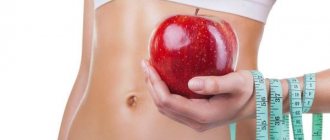Actions of iodine
The content of the article
The most important effect of iodine is antimicrobial and it is used as an antiseptic. It has an irritating effect on the skin and mucous membranes.
By using iodine preparation internally, cholesterol is reduced, thereby it has a beneficial effect on metabolic processes, accelerating them.
Iodine affects the functioning of the thyroid gland on two fronts, namely, in hypothyroidism it takes part in the formation of thyroxine, and in case of hyperfunction in small dosages it inhibits the formation of thyroxine. Organic iodine compounds are used as radiocontrast agents.
Iodine-rice diet
Iodine-based diets not only help you get rid of extra pounds, but also have a pronounced therapeutic effect. When losing weight, the main ingredients are rice and seaweed. Rice helps digest foods rich in iodine.
| Diet days | Breakfast | Dinner | Dinner |
| First day | A serving of boiled rice, green tea | 100 grams of steamed fish, boiled rice, herbal decoction | 2 eggs, 150 grams of seaweed salad, 200 ml of green tea |
| Second day | 150 grams of boiled rice, 150 ml of green tea | 100 grams of rice, a small amount of shrimp, two oatmeal cookies, herbal tea | A portion of boiled fish, herbal infusion |
| The third day | Boiled rice, green tea | 100 grams of boiled squid meat, 3 tomatoes, 200 ml tea | 3 medium sized shrimp, boiled rice |
| Fourth day | Salad made from crab meat, eggs and seaweed, green tea | A serving of boiled rice, a few lettuce leaves, fruit juice | ½ part boiled beets, a portion of rice, 200 ml tea |
| Fifth day | 0.15 kg of dark grapes, 200 grams of boiled rice | The lunch menu of one of the previous days is repeated | 150 grams of low-fat yogurt, salad with seaweed |
| Sixth day | A serving of tomato, sesame and radish salad, dressed with olive oil, green tea | 150 grams of boiled beans, a small amount of boiled meat, 200 ml of fruit juice | 3 potatoes, boiled in their jackets, green tea |
| Seventh day | 100 grams of low-fat cottage cheese, green tea | 200 ml milk (or other fermented milk drink) | Porridge cooked with milk, 100 grams of boiled chicken fillet |
Be sure to read: The effectiveness and dangers of using hydrogen peroxide for weight loss
A diet that involves eating iodine and rice is quite filling. It helps replenish iodine deficiency, saturates the body with minerals and vitamins.
When losing weight, it is advisable to give preference to brown rice. This product contains quite a lot of fiber, which helps reduce cholesterol and normalize the functions of the digestive system. Rice helps strengthen the heart muscle. The product activates the process of removing salts from the body. Rice has a beneficial effect on the intestinal mucosa.
Symptoms of iodine deficiency in the body
The very first sign of iodine deficiency in the body is fatigue, drowsiness, and bad mood. A person often begins to get sick with colds, viral, and fungal diseases, because he has a weakened immune system. Swelling often occurs in the eye area, arms and legs, so even taking diuretics is useless.
In girls and women, iodine deficiency affects the menstrual cycle, making it irregular due to an unstable hormonal system, which can lead to infertility or early menopause. Iodine deficiency is dangerous during pregnancy and there is a very high risk of fetal loss, as well as intrauterine pathologies of the fetus. Iodine deficiency is accompanied by anemia, namely iron deficiency, the manifestations of which are: weakness, dizziness, pale skin, nausea.
Increased body weight is one of the manifestations of a significant lack of iodine in the human body. As stated above, a lack of iodine leads to disruption of metabolic processes and accumulation of fluid in the body.
Since body weight is increased, problems begin with the cardiological (shortness of breath, heart pain, hypertension or, conversely, hypotension, rapid heartbeat), musculoskeletal system (pain in the joints, difficulty moving), respiratory system (pulmonary failure, wheezing in the lungs), often Hair loss and brittle nails are also noted.
Iodine deficiency conditions in pediatric practice
I.D.Bykova, pediatrician of the highest category, E.V.Shtul, pediatrician of the highest category
Introduction At an outpatient appointment in a children's clinic, pediatricians quite often encounter a variety of complaints from parents about the health of their children. Fatigue, weakness, drowsiness, decreased memory, attention, decreased school performance, delayed psychomotor development in the 1st year of life, frequent colds, tendency to edema, dry skin, hair loss or impaired growth, brittle nails, delayed teething or enamel defects, constipation, anemia, stunting, excessive weight gain, menstrual irregularities in girls, hypothermia. — a competent pediatrician, if a child of any age has at least one of these problems, will definitely think about the need to exclude thyroid pathology, in particular iodine deficiency in the body, and consult with an endocrinologist.
Among all pathologies of the endocrine system, diseases of the thyroid gland occupy a leading place, and iodine deficiency conditions are one of the most common non-infectious human diseases.[4] It has now been proven that in addition to the formation of goiter, iodine deficiency has other adverse effects on human health. Pathology of the thyroid gland - often a non-toxic goiter - is the most common manifestation of endocrine system disease in children.
Lack of iodine creates new conditions for the functioning of the body and its systems, for metabolism:
- decreased attention and memory;
- retardation in mental and physical development due to brain damage at different stages of formation;
- slowing down the child's growth;
- decreased intelligence;
- fast fatiguability;
- decreased immunity and performance;
- obstetric problems;
- an increase in the frequency of congenital deformities, stillbirths, an increase in perinatal and infant mortality;
- damage to the visual and auditory analyzers;
- neurological disorders;
- pathologies of the cardiovascular and musculoskeletal systems;
- dysfunction of the thyroid gland, development of goiter.
The main risk group for developing iodine deficiency diseases are pregnant, lactating women and children under 3 years of age and adolescents. In Russia, an increase in the frequency of cases of cretinism (severe mental retardation) associated with intrauterine iodine deficiency and iodine deficiency in nutrition, leading to disability and social maladaptation, has again been registered. Iodine is part of the thyroid hormones and is responsible for the development and normal functioning of the child’s nervous system, participates in the formation of intelligence, controls growth and physical development, stimulates metabolic processes, and participates in the development of all organs and systems. Thyroid hormones (TH) have a wide range of actions. Their role is important in the life of a person of any age, but the role of thyroid hormones is especially important during the period of intrauterine and early postnatal life. The most important effect of TG in childhood is the anabolic effect.
Unlike other anabolic hormones, TG not only and not so much control linear growth, but rather regulate the processes of tissue differentiation. It is under the influence of TG that children not only grow, but also mature and mature. During the period of intrauterine life, under the control of TG, the processes of embryogenesis are carried out, almost all organs and systems differentiate and mature.[5] THs have an exceptional effect on the formation and maturation of the brain. No other hormones have a similar effect. In the early stages of intrauterine life, under the influence of thyroid hormones, the basic functions of the brain are laid and formed.
The timing of brain differentiation is clearly limited in time. TG deficiency at any of these stages leads to the fact that the brain stops developing and undergoes degenerative changes. In most regions of Russia, the natural environment contains insufficient amounts of iodine. At the same time, it is known that iodine is a necessary component for the synthesis of thyroid hormones. Consequently, iodine deficiency in the natural environment leads to a decrease in the synthesis of thyroid hormones (TG), i.e., it causes a decrease in the functional activity of the thyroid gland. The most common manifestation of iodine deficiency in the environment is the presence of endemic goiter. Goiter in conditions of iodine deficiency forms in a person at any age, most often during puberty. At the same time, the manifestations of hypothyroidism gradually increase, although clinically pronounced forms of the disease are extremely rare in childhood and adolescence.
At the same time, during a hormonal examination, more than half of children and adolescents with an enlarged thyroid gland show signs of so-called subclinical hypothyroidism: there is a tendency to decrease or low T4 levels, normal or slightly increased T3 values and increased TSH levels. Children with goiter have worse indicators of physical and sexual development, study worse at school, their health is worse in many respects: they get sick more often and more severely, more often have chronic diseases, changes in the cardiovascular system, blood counts, etc. Specific clinical Symptoms of iodine deficiency diseases are often absent. This explains the late referral to an endocrinologist and the neglect of pathologies.
For a correct diagnosis, ultrasound of the thyroid gland and determination of the level of thyroid hormones are of great importance. Test systems with high functional sensitivity are used to determine hormone levels. A timely examination allows you to avoid mistakes in diagnosing thyroid diseases and prescribe adequate therapy. At the 40th session of the UN in September 2005, the UN Committee on the Rights of the Child reviewed regular reports from countries on the implementation of the obligations of the Convention on the Rights of the Child, including the report provided by the Russian Federation. The Committee expressed concern about iodine deficiency disorders in Russia and called for increased preventive measures and the adoption of a law on universal salt iodization and its strict enforcement. The conclusions of UN experts are fully consistent with the main themes of the Annual Address of the President of the Russian Federation to the Federal Assembly of the Russian Federation, dedicated to the urgent need to optimize the demographic situation in Russia.
In this regard, the most pressing issue at present is the organization of preventive measures to increase iodine consumption by the population to a physiological level. For this purpose, mass (blind), group and individual iodine prophylaxis is carried out. Mass iodine prophylaxis involves the sale of iodized salt. Daily consumption of such salt in quantities familiar to the patient (5-10 g) allows you to receive 150-200 mcg of iodine per day. As a result, a person receives an adequate amount of iodine through diet - about 150-200 mcg. Carrying out population-based prevention of iodine deficiency diseases using iodized salt is an effective, tested and internationally recognized method. Under special control when carrying out iodine prophylaxis, there should be groups of the population with the highest risk of developing IDD and the most severe consequences of iodine deficiency: - women of childbearing age, - pregnant women and nursing women, children (0-3 years old) and adolescents.
According to the recommendations of the World Health Organization, to meet the body's need for iodine, the following norms of daily consumption have been adopted: - for infants (0–2 years) - 50 mcg; - for young children (2–6 years old) - 90 mcg; -for school-age children (7–12 years old) – 120 mcg; - for older children and adults (12 years and older) - 150 mcg; -for pregnant and lactating women - 250 mcg of iodine. The prescription of pharmacological preparations containing a strictly fixed dosage of potassium iodide makes it possible to effectively meet the increased needs of the body. For breastfed infants, this issue is resolved by correcting the mother’s diet, in which great importance is attached to regular intake during lactation.
For children who do not receive mother's milk from birth or after the third to sixth month of life, the only baby food products that can provide them with the necessary amount of iodine are artificial milk formulas enriched with the microelement (human milk substitutes) and cereals based on them. human milk. In the second half of life, additional iodine is necessary in the composition of pharmacological tablets and (or) complementary feeding products (porridge, natural products). If the mother is breastfeeding and does not receive iodine prophylaxis for any reason, the child needs to take at least 90 mcg daily. Children aged 1 to 3 years The level of iodine in salt during mass preventive measures corresponds to the needs of an adult receiving from 4 to 10 g of table salt per day. In children, especially those under three years of age, the need for sodium is several times lower, and the need for iodine is only slightly less than in adults, amounting to 90 mcg per day.
Therefore, the amount of iodine a child receives from table salt may not be sufficient. To compensate for the deficiency of this microelement in this age group, physiological doses of iodine must be used in the composition of potassium iodide tablets. Puberty During puberty, the function of the thyroid gland undergoes certain changes associated with adaptation to the rapid pace of growth and development. The same doses of iodine are recommended as for adults - 150 mcg per day. The preferred method of preventing endemic goiter in adolescents is the administration of potassium iodide preparations.
For the treatment of euthyroid endemic goiter in children and adolescents, as a rule, it is sufficient to prescribe iodine preparations in a physiological dose of 150–200 mcg per day. Normalization of the size of the thyroid gland usually occurs within six months. If there is no effect after 6 months of treatment with iodine preparations, therapy with thyroxine preparations is prescribed. In this case, after normalizing the size of the thyroid gland, thyroid hormones are canceled and lifelong iodine intake is prescribed in a “maintenance” dose of 100–150 mcg per day. However, in each specific case, treatment is carried out individually. Goal of the work. To evaluate the effectiveness of the use of iodine preparations in pregnant women, nursing mothers, and children in the first year of life for the purpose of preventing iodine deficiency conditions. Materials and methods Conducted on the basis of the KGBU city clinic No. 15 in the pediatric department. An analysis was carried out of the conduct of prenatal care for women registered for pregnancy, the timeliness of their registration for pregnancy, the timing of prescription and regularity of taking iodine-containing drugs, the analysis of outpatient cards of children in the first year of life, the use of iodine-containing drugs by nursing mothers, the rational choice of adapted formulas for children on artificial feeding, taking iodine-containing drugs during the first year of life in these areas for 2010-2014.
486 prenatal visits and 1493 outpatient records were analyzed. Results and discussion Iodomarin was chosen as a drug for prevention. The use of this drug in pediatric practice in areas has been used for more than 10 years. Due to insufficient awareness of mothers on the problem of iodine deficiency conditions and their consequences, over the past five years, work with pregnant women and mothers of children in the first year of life has been intensified in order to prevent iodine deficiency conditions. Prevention of the birth of children with congenital birth defects, neurological diseases, especially prevention of cases of cretinism, prevention of anemia, physical development disorders, intellectual impairments. As a result of the work, it should be noted that the percentage of pregnant women taking iodomarin during pregnancy increased. In 2010, 87% used iodomarin during pregnancy. In 2011, the percentage increased to 90%., 2012 to 90.5%, 2013 to 92.5%. By 2014, the percentage of pregnant women taking iodomarin during pregnancy reached 96.5%.
To prevent iodine deficiency conditions in the first year of life, it is recommended that nursing mothers use iodomarin at a dose of 200 mcg/day and use only adapted formulas in bottle-fed children. In children over one year old, iodomarin was used at a dose of 100 mcg/day. As a result, over the past 5 years, there have been no cases of births of children with congenital hypothyroidism in the clinic. The number of children born with transient thyroid disorders ranged from 25 cases in 2010 to 17 cases in 2014. As a result, over the past 5 years there has been a decrease in the number of children with developmental defects, anemia, neurological disorders, and delayed physical development in the first year of life.
Medicines that increase iodine content in the body
At the moment, there are many drugs that combat iodine deficiency in the human body; they are easily available for purchase in pharmacies. In addition to medications containing iodine, you must take multivitamins, which help it be well absorbed in the body.
ONLINE REGISTRATION at the DIANA clinic
You can sign up by calling the toll-free phone number 8-800-707-15-60 or filling out the contact form. In this case, we will contact you ourselves.
If you find an error, please select a piece of text and press Ctrl+Enter
Iodine mesh for weight loss. The benefits of iodine for weight loss and the body as a whole
The properties of iodine prevent thyroid diseases, the occurrence of goiter, and promote the formation of phagocytes that fight harmful effects on the body. In addition, it reduces irritability and fatigue, promotes protein synthesis, and stimulates brain function.
Its deficiency destroys the psyche, makes a person nervous and aggressive. For girls, the benefits of iodine are also enormous: it improves the condition of hair and nails, metabolism and lipids, and eliminates the appearance of cellulite.
Iodine is prescribed for diabetes, obesity, anemia, edema, hypertension, bronchitis, and headaches. Pregnant women often drink it for normal fetal development.
Iodine does not have to be taken in tablets; many foods can easily fill the daily dose: seaweed, seafood, champignons, beans, fruits. However, there are also foods such as radish or white cabbage that, on the contrary, flush it out of the body.
Obesity or underweight can be caused by thyroid dysfunction. Only an endocrinologist can identify this after an examination. Often patients are diagnosed with hypothyroidism. It is characterized by a decrease in thyroid function, resulting in apathy, deterioration in appearance and well-being.









